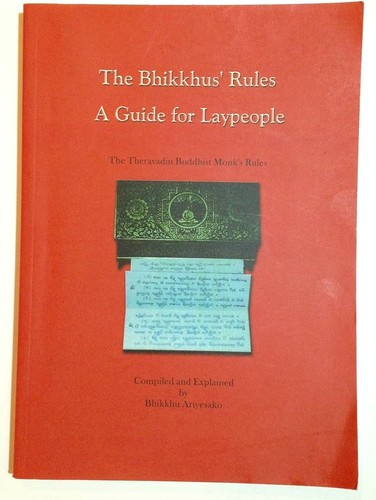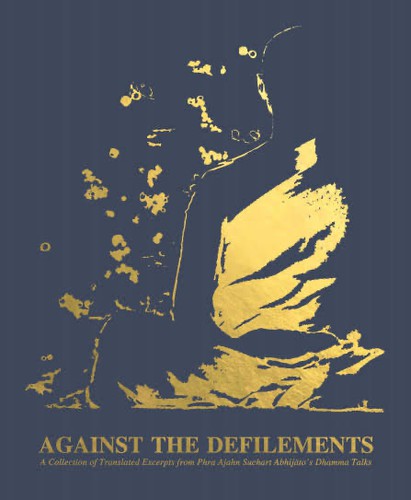Monastic Buddhism
Subscribe to this topic via: RSS
The form of Buddhism practiced by celibate renunciates.

A Tibetan nun in Dharmasala, Indian holds a colorful umbrella to shield herself from the sun. (Steve Evans, CC BY 2.0)
Table of Contents
Books (8)
Featured:
-
144 pages
See also:
Canonical Works (41)
Featured:
-
⭐ Recommended
Is it possible, venerable sir, to point out any fruit of recluseship that is visible here and now?
-
The Venerable Aniruddha tells the monks about his practice of austerity.
-
… there is no true wandering: that is how it appears to me
-
⭐ Recommended
Just as the great ocean has but one taste, the taste of salt, so too, this Dhamma and discipline has but one taste: the taste of liberation. This is the sixth astounding and amazing quality…
-
The Buddha has rid us of so many things that bring suffering and gifted us so many things that bring happiness!
-
There is no single bhikkhu, brahmin, who possesses in each and every way all those qualities that were possessed by the Blessed One, accomplished and fully enlightened. For the Blessed One was the arouser of the unarisen path
-
The Buddha gives an alternate version of “the eight precepts” which separate a layman from a renunciant and provides a series of similes about the dangers of sensual pleasures.
-
What did you expect, Aggivessana? For Prince Jayasena—living in the midst of sensuality, consuming sensuality, chewed on by thoughts of sensuality, burning with the fever of sensuality, intent on the search for sensuality—to know or see or realize that which is to be known through renunciation, seen through renunciation, attained through renunciation, realized through renunciation: That’s impossible.
-
Here, a bhikkhu lives in dependence on the Teacher or on a certain fellow monk in the position of a teacher, toward whom he has set up a keen sense of moral shame and moral dread, affection and reverence…
-
Five factors that a mendicant should have, and five factors a lodging should have, for meditation progress to be swift.
-
Whoever has no respect
for their spiritual companions… -
⭐ Recommended
Bhante, on how many grounds has the Tathāgata prescribed the training rules for his disciples and recited the Pātimokkha?
-
Wanderers of other religions advocate three kinds of seclusion. What three? Seclusion in robes, almsfood, and lodgings.
-
One is unripe but seems ripe,
One is ripe but seems unripe… -
A mendicant with these five qualities is an exquisite ascetic of ascetics.
-
Why do you live as if lost?
See also:
Readings (33)
Featured:
-
All monastics, but Bhikkhunis especially, feel a tension between practicing restraint for their own development and practicing in ways that others expect. This article discusses the role of power and tradition within one such context.
-
… whatever the various reactions to a Buddhist monk people might have, fear is highly unlikely to count amongst them. People see a Buddhist monk and they know that he is not dangerous
-
⭐ Recommended
The brahmins would indeed take umbrage at being closely associated with the officiant, because the very fact of his being there as an officiant means that he is doing a paid job and so lowers his status below theirs. [The brahmins, in contrast,] have no duties; they are gracing the occasion.
-
What is it really that leads to the decline of the religion?
-
… these delightful mountain solitudes,
Are like the family estate to the supreme guide’s heirs,
And, as the best of protectors himself has said,
To rely on solitude is indeed the pinnacle of joys! -
Six challenges (opportunities) faced by monasticism in the modern world.
-
⭐ Recommended
Human born.
Faculties intact.
Full of youth.
To encounter the Dharma is marvelous! -
Ultimately, Buddhism isn’t about “becoming” anything. A former Tibetan monk points out one of the amazing things about the Buddhist (as opposed to some other) monastic traditions: it’s always possible to disrobe.
-
A short essay on what constitutes wrong livelihood for a monastic.
-
My loved ones had slowly adjusted to my new direction in life, yet were still stunned that I carried out the final step, leaving everything behind—as this implied that the world has nothing to offer, ever. It made a big impact upon them.
See also:
Audio/Video (15)
Featured:
-
🥇 Best of
 1h 26 m
1h 26 m -
Thubten Chodron tells us about her journey from hippie to nun, her concern about the dharma being stripped from its Buddhist world view, and the challenges of being a Western monastic.
-
Most people aren’t interested in seriously practicing Buddhism because most people don’t appreciate renunciation, contentment, seclusion, effort, mindfulness, and wisdom.
-

See also:





